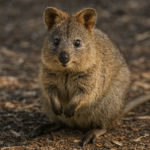
Toboorburra, NSW, 21Sep1979, ANWC R2861
A bearded dragon is a type of lizard. This animal is native to Australia, but it has become one of the most popular reptiles in America since the 1990s. Deserts, arid and rocky areas, dry forests, and scrublands are all natural habitats for the bearded dragon. It is mostly found in Australia’s eastern and central regions. Despite the fact that many bearded dragons were removed from their natural environment as a result of the pet trade, their population in the wild remains stable. They are not listed as endangered.
The average bearded dragon can grow to be 16 to 22 inches long. Males are physically larger than females. The tail is usually half the length of the body.
The bearded dragon’s body is tan to yellow in color. It has spines on both sides of the throat, both sides of the head, and both sides of the abdomen. It has a triangular head. The body is muscular and well-supported by strong legs.
The bearded dragon got its name because it can enlarge its throat (which resembles a beard) when threatened or defending its territory.
A couple of characteristics distinguish males and females. Males have larger heads, darker beards, and are taller than females. Females’ tails are thinner and more slender than males’.
The bearded dragon prefers to live in bushes and trees, but it can also be seen basking on rocks.
The bearded dragon is an omnivore, which means it eats both plant and animal foods. It primarily consumes insects, small rodents, lizards, and leafy plants.
Bearded dragons have distinct ways of greeting other members of the group or displaying submission in the presence of a more dominant male. It will stand on three legs, with the remaining leg rotating in the air.
When threatened, bearded dragons take on a “scary appearance.” They can enlarge their throats and flatten their bodies.
The bearded dragon can regulate its body temperature by changing the shades of skin color from light to dark and vice versa.
Large lizards, dingoes, and birds of prey are the primary predators of bearded dragons.
Bearded dragons, unlike other lizards, are unable to detach their tails when fleeing predators. They will be unable to repair the damage if their tails are lost (they will be tailless for the rest of their life).
Bearded lizards aren’t particularly fast runners. They can only run at 9 miles per hour.
Bearded lizards do not have a specific breeding season; instead, they can reproduce all year.
Bearded dragons reach sexual maturity between the ages of 8 and 12 months.
The bearded dragon has an average lifespan of 4 to 10 years.








